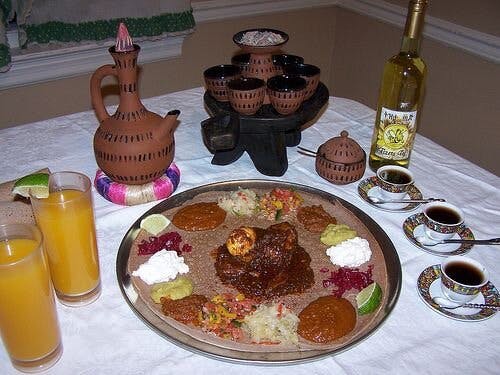Injera: A brunch in Abyssinia

While Abyssinia strictly refers to just the North-Western Ethiopian provinces of Amhara and Tigray as well as central Eritrea, it was historically used as another name for Ethiopia. The typical Ethiopian cuisine is “Injera” (large sourdough flatbread) as well as several kinds of “wat” (stew). Injera is an Ethiopian sour flatbread made from teff flour, gluten-free flour made from the African grain teff. The best known Eritrean-Ethiopian cuisine consists of various vegetable or meat side dishes and entrees, usually a wat, or thick stew, served with Injera.
Traditional Ethiopian cuisine employs no pork, as they are forbidden in the Islamic, Jewish, and Ethiopian Orthodox Christian faiths. It is also very common to eat from the same big dish in the center of the table with a group of people. Ethiopian Injera is not just a delicacy, it is also used as an eating utensil to scoop up the entrees and side dishes, and as a plate. And often in place of the tablecloth. A variety of stews, vegetables and/or salads are placed on a large piece of Injera and guests use their right hands to tear portions of the injera which are used for gripping the food. The porous texture of the injera makes it ideal for soaking up the juices.
Injera can be eaten with up to 112 toppings, both vegetarian and non-vegetarian, which one assembles on their own depending on what their favorites are. Toppings that go with Injera include: Kitfo (Traditional Marinated Minced Meat (can sometimes be eaten raw), Shiro (Stew made from Ground Pulses), Kei Wot (Ethiopian Style Beef Stew), Gomen (Collard Greens), Kik Alicha (Yellow Split Pea Curry), Kei Tibs (Stir Fried Beef), Tibs (Spicy Beef Stew), Kei Sir (Red Roots), Atakilt (Ethiopian Style Cabbage), Misir (Spiced Red Lentils), Fossolia (Ethiopian Style Green Beans) and Dinach (Mashed Potato).
The main drink that goes with Injera is Ethiopia's Coffee Arabica served in black clay coffee pot, locally known as Jebena. Round at the bottom with a straw lid, it is placed on a circular band of straw. Small, often decorated china cups, known as Sini, are lined up together with a sugar jug on a special wooden curved tray with four short legs, like a miniature table.
Eaten all together, the experience is unforgettable. Abyssinian taste is just magical.
Mahfudh Khamisi
